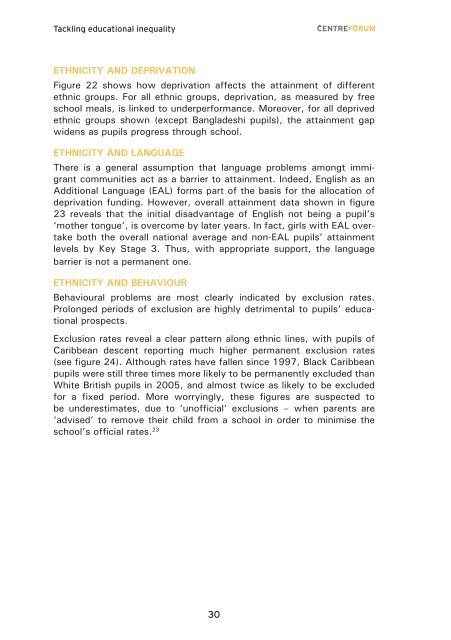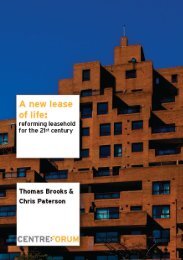Tackling educational inequality - CentreForum
Tackling educational inequality - CentreForum
Tackling educational inequality - CentreForum
You also want an ePaper? Increase the reach of your titles
YUMPU automatically turns print PDFs into web optimized ePapers that Google loves.
<strong>Tackling</strong> <strong>educational</strong> <strong>inequality</strong><br />
Ethnicity and deprivation<br />
Figure 22 shows how deprivation affects the attainment of different<br />
ethnic groups. For all ethnic groups, deprivation, as measured by free<br />
school meals, is linked to underperformance. Moreover, for all deprived<br />
ethnic groups shown (except Bangladeshi pupils), the attainment gap<br />
widens as pupils progress through school.<br />
Ethnicity and language<br />
There is a general assumption that language problems amongt immigrant<br />
communities act as a barrier to attainment. Indeed, English as an<br />
Additional Language (EAL) forms part of the basis for the allocation of<br />
deprivation funding. However, overall attainment data shown in figure<br />
23 reveals that the initial disadvantage of English not being a pupil’s<br />
‘mother tongue’, is overcome by later years. In fact, girls with EAL overtake<br />
both the overall national average and non-EAL pupils’ attainment<br />
levels by Key Stage 3. Thus, with appropriate support, the language<br />
barrier is not a permanent one.<br />
Ethnicity and behaviour<br />
Behavioural problems are most clearly indicated by exclusion rates.<br />
Prolonged periods of exclusion are highly detrimental to pupils’ <strong>educational</strong><br />
prospects.<br />
Exclusion rates reveal a clear pattern along ethnic lines, with pupils of<br />
Caribbean descent reporting much higher permanent exclusion rates<br />
(see figure 24). Although rates have fallen since 1997, Black Caribbean<br />
pupils were still three times more likely to be permanently excluded than<br />
White British pupils in 2005, and almost twice as likely to be excluded<br />
for a fixed period. More worryingly, these figures are suspected to<br />
be underestimates, due to ‘unofficial’ exclusions – when parents are<br />
‘advised’ to remove their child from a school in order to minimise the<br />
school’s official rates. 23<br />
30





